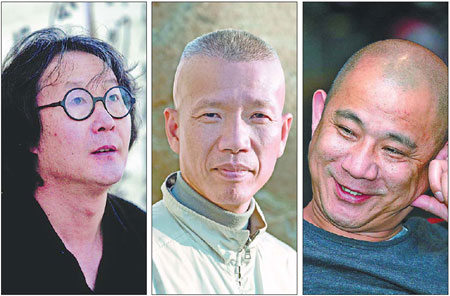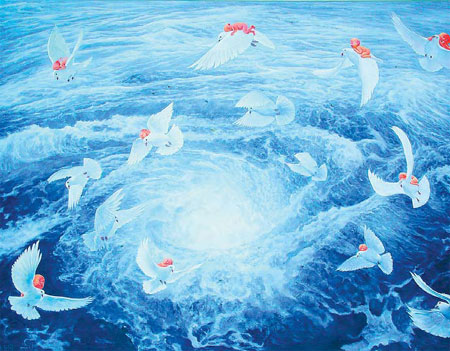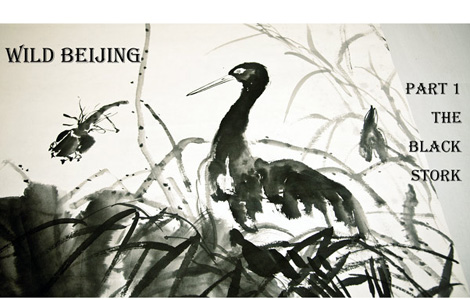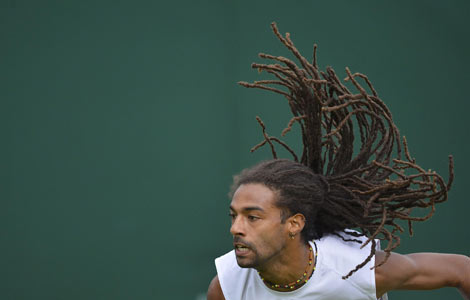Chinese palette
Updated: 2013-07-01 08:04
By Mariella Radaelli (China Daily)
|
|||||||||||
|
A-list Chinese artists like Xu Bing (left), Cai Guoqiang (center) and Fang Lijun are well represented at the Venice Biennale. Photos Provided to China Daily |
|
Dream of Peace, oil on canvas by Fang Lijun. |
Europeans have developed a taste for the diverse array of works by China's artists on show at the Venice Biennale. Mariella Radaelli reports.
Contemporary Chinese art has a strong presence at this year's Venice Biennale, evidence of a growing appetite for it across Europe.
Stimulating exhibitions displaying the works of both new and established artists that are surprising, entertaining and moving represent a diverse national artistic landscape that is winning growing global respect.
An exhibition titled Culture-Mind-Becoming, which opened at the biennale on June 1, aims to embrace the complexity of thought and themes characteristic of contemporary Chinese art, with its free and unexpected aesthetics.
Presented by the Global Art Center Foundation at Palazzo Mora and Palazzo Marcello, it illustrates and interprets the major expressions of an extremely heterogeneous art scene.
The exhibiting artists include renowned names familiar to the US and European art circuits, such as Xu Bing and Cai Guoqiang, while the solo show A Cautionary Vision is devoted to Fang Lijun, a prominent representative of post '89 China New Art and an exponent of the so-called cynical realism movement.
Fang's art is an emblematic and remarkable example of how a modern-day A-list Chinese artist pushes deeply into pure painting, avoiding the influences of the signal movements of modern art.
Fang took a formative trip to Germany. But his approach is immediate, not mediated by the European avant-garde, from Futurism to Surrealism, which changed the course of painting so dramatically.
Fang's 15 large paintings are on display at Palazzo Marcello. Each is 7 to 8 meters wide and depicts magnificent scenery, figures of people either floating in clouds or dwelling in the sea, and newborn babies riding storks or enclosed in claustrophobic bubbles. All the well-balanced compositions are characterized by a playful, ironic painterly touch and a vivid sense of fragments.
According to curator Danilo Eccher, current director of Galleria Civica d'Arte Moderna e Contemporanea in Turin, Fang's art expresses a cautionary vision of the structural intricacies of reality, so it demands to be analyzed and interpreted in the context of complex theory, which interconnects with chaos theory, complex algorithms and quantum physics.
His art is imbued with the Eastern metaphorical visual tradition.
"It enshrines all the secrets of the East," Eccher says. "A sweet, simple figurative style enveloped in a brilliant use of color; a visionary, childlike fascination with an unattainable world; and a calm, graceful, balanced narrative. But all of this is just the brilliant patina of a style of painting that is able to suggest the contemporary anguish of loss of identity, the obsession of the collective, the presence of disease, pain, sin.
"Fang Lijun does not simply dramatize contradiction; rather than limit himself to the astonishing effect of opposition, his cynical realism is in reality a narrative about complexity, about the art of chaos that refutes linear interpretation, and that is immersed in an engorgement of languages and meanings."
Having innate insights into the popular knowledge of his national heritage, Fang is an epic storyteller whose art derives from a sensitive observance of the vast reality of his native China.
Eccher considers Fang one of the most innovative of today's painters.
"His figurative paintings, so purely Chinese, are at the virtuoso level both in technique and precision, especially regarding his passion, so typically Chinese, for details."
Interest in contemporary Chinese art has grown enormously over the past 20 years.
The International Art Venice Biennale first presented artists from the Chinese mainland exactly 20 years ago.
"After the pioneering phase of great enthusiasm and curiosity, which started in the early '90s, about 10 years ago we moved on to a second phase, entirely focused on investigation, a more accurate study and critical analysis," Eccher says.
Germany was the first European country to establish stable relationships with Chinese artists, he says.
Eccher insists that Italy is one of the countries most interested in Chinese art.
"Several collectors and specialized galleries, such as Galleria Continua and Primo Marella, have opened branches in Beijing. In general, many galleries both in Europe and the United States have expanded their operations into China, an extremely creative part of the world nowadays."
Today's Chinese artists are at a riveting stage, with the majority being well-educated, according to Eccher.
"A-list Chinese artists know Western art history quite well, but are not affected by the very idea of the avant-garde, which has been introduced through contact with the West, since it does not belong to their own spirit and DNA," he says.
"That is why their signature iconography is much freer. That is why Chinese art is an incredible aesthetic laboratory in which artists can experiment with new interpretative methodologies."
The European viewer interacts with a Chinese painting in a less predictable way than when put in front of a contemporary Western art object, he says.
This makes this particular "Chinese experience" more challenging, he says.
It is almost obligatory now to mention the presence of Xu Bing and Cai Guoqiang, both in the first and second sections of the exhibition.
Xu, widely regarded as one of the most important artists of his generation for informing his work with language and history, presents his new multimedia installation Work on Site in Venice.
Cai, whose artistic language has a direct and deliberate reference to Chinese iconography (his gunpowder works are renowned across the globe) returns to Venice for the third time.
The first collective section titled Rediscover, which is organized by independent Dutch curator Karlyn De Jong, highlights the fact that many Chinese artists feel obliged to rediscover their own cultural roots as a source of nutrition for their work.
"Chinese art is visually quite different. Since it is so richly varied, and understanding it requires a lot of knowledge, it is an easy way out to just say it is 'not good'," De Jong says. "For me, art is always an expression of a human act, no matter whether I personally like it or not."
(China Daily 07/01/2013 page22)
Today's Top News
Russia's Putin signs anti-gay measures into law
Fugitive terror suspect nabbed in Xinjiang
New NSA spying allegations rile EU
New exit and entry law effective
Massive debt plagues local gov't
Foreign minister makes ASEAN debut
Ministry drafts child welfare system
'Overseas talent drive requires more guidance'
Hot Topics
Lunar probe , China growth forecasts, Emission rules get tougher, China seen through 'colored lens', International board,
Editor's Picks

|
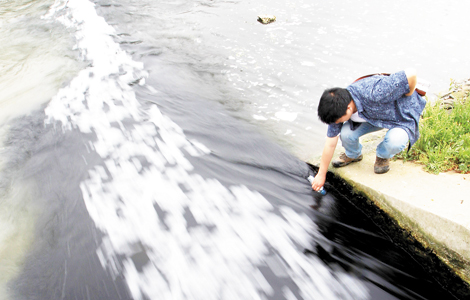
|
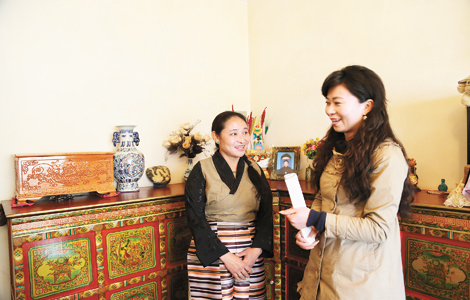
|
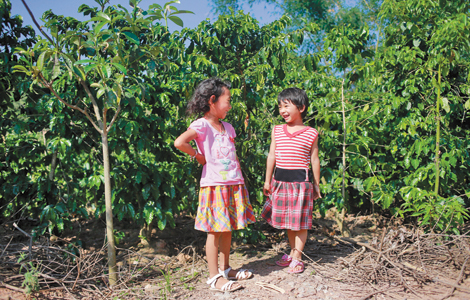
|
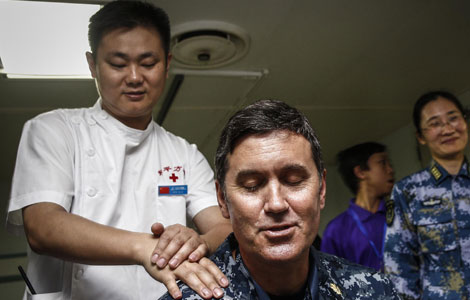
|

|
